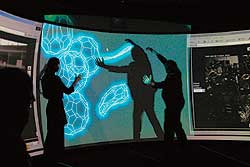|
By Alan Joch
Moving into the new century
What does an electronics company do when its showpiece technology
lab starts to show its age? For Sony Corporation, the answer
was to renovate, to the tune of $4 million and months of brainstorming.
Sony’s four-story Wonder Technology Lab, designed by
Ed Schlossberg, opened in New York City in 1994—an epoch
ago measured in high-tech time. “We wanted to move from
analog facility to digital facility,” says Ann Morfogen,
a Sony senior vice president. Sony also wanted to differentiate
the renovation from a design perspective. “When the lab
first opened, people were wowed by the physical language of
technology—the wires, connections, and hardware,”
notes the project’s architect, Lee H. Skolnick, FAIA,
principal of Lee H. Skolnick Architecture + Design Partnership
in New York. “It was a case of wearing technology on
your sleeve.”
In the renovation, which opened in October, the emphasis
is instead on integrating technology into the physical design.
“We wanted a look that was modern, cool, comfortable—and
to forget about the hardware,” Skolnick says. A team
from Sony joined forces with Skolnick’s group and an
A/V systems integrator for six months of “creative interaction,”
Morfogen says. Josh Weisberg, principal of the systems integrator,
Scharff Weisberg of Queens, joined the team early because
the underlying A/V needs would be key to bringing the creative
ideas to life. “We couldn’t simply use consumer
devices—we had to take the technology to the next level
with sophisticated computer systems to handle all of this
processing,” Skolnick says. The majority of the computers
run in a behind-the-scenes, 8-by-12-foot room where custom-designed
controls automatically run digital-video servers and the lighting
system.
 |

Visitors to LACMA’s
nano play with supersize images of molecules called
Buckyballs, named for their resemblance to Buckminster
Fuller’s domes.
Photography:Courtesy UCLA Academic Technology Services
staff |
|
 |
Because it wanted to emphasize the “magic” of technology,
the design group eschewed monitors and keyboards in favor
of wall-size video projections, vibrating floors, and sensor-activated
instruments that place visitors within the exhibits, Weisberg
says.
For example, the games exhibit isn’t merely an arcade
to display the latest and greatest video systems—instead,
visitors find themselves immersed in a game thanks to A/V
technology such as directional sound and large-screen monitors.
A related exhibit lets visitors create a racetrack and cars
for their own auto racing game. This “activated environment,”
Skolnick says, relies on modulated lighting and video images
that move across the floors. A curved wall stretches throughout
the renovated second-floor space to act as a common design
element, tying the exhibits together. Made of a custom lenticular
material, the wall’s surface ridges are molded at various
angles that refract the changing color patterns shining through
from behind the wall. “As you move through the lab, the
visuals on the wall change,” Skolnick explains. “We
developed a color palette for the entire space, and you see
all of those colors on the wall.” Skolnick worked with
a British supplier to produce the material in large, wall-size
sheets, rather than the small panels typically manufactured
for toys and advertising trinkets. “Using the material
on this scale, as an environmental element, was a new thing,”
Skolnick says.
Another challenge was how to use the open, skylit atrium
space adjacent to the lab to attract attention. “We wanted
people in the atrium to see how visitors in the lab were empowered
to do exciting things,” says Skolnick. The design team
created a video montage, using real-time, live-action scenes
from inside the lab, and a bay window in the atrium as a large
projection screen. To cut down on glare and reflections, they
treated the window with a self-adhesive, high-gain acrylic
film that provides a surface opaque enough to display the
images, but translucent enough to let light pass through.
For Skolnick, whose company has been designing interactive
exhibits for 20 years, the lesson of this project is that
design and technology will continue to become ever more intertwined.
“It’s not about people just pushing buttons, but
rather, it’s creating more natural interfaces to bridge
architecture and technology and make them one.”
|


















